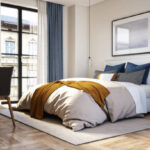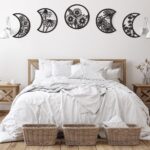The best color for a bedroom is subjective, often light blue or soft green. These colors promote relaxation and tranquility, essential for a restful sleep environment. What is the Best Color for a Bedroom?
Selecting the perfect hue for a bedroom is more than a matter of aesthetic taste; it can impact sleep quality and mood. The psychology of color influences our emotions, so choosing a calming shade is key. Light blue evokes feelings of peace and serenity, mimicking the sky and sea, which can help reduce stress.
Soft green brings the natural world to mind, offering a refreshing and soothing effect. Beyond personal preference, consider these hues to create a welcoming and restorative bedroom sanctuary. To ensure a harmonious space, coordinate your color choice with lighting and decor for a cohesive and comforting bedroom design.
Color Psychology In Bedroom Design
Choosing the right color for a bedroom is more than just about aesthetics. Color psychology plays a key role in bedroom design. It affects not only the look of your room but also your mood and sleep quality. Let’s explore how different hues can impact the ambiance of your bedroom and your well-being.
Influence Of Color On Sleep
Sleep quality correlates with bedroom colors. Soft, calming shades foster relaxation and can help improve sleep. Here’s a quick guide to colors that contribute to better sleep:
- Blue: Lowers blood pressure, leading to better sleep.
- Green: Promotes restfulness and comfort.
- Light Pink: Evokes calmness and warmth.
- Soft Gray: Provides a tranquil environment.
Emotional Impact Of Bedroom Colors
Colors not only transform a space but also evoke different emotions.
| Color | Emotion |
|---|---|
| Red | Excitement and energy |
| Yellow | Happiness and positivity |
| Purple | Luxury and creativity |
| Orange | Enthusiasm and warmth |
Remember, soft and muted tones often work best for a soothing bedroom environment.
Top Contenders For Serene Bedroom Hues
Choosing the right color for your bedroom is key to a restful night’s sleep. Certain hues encourage calmness and relaxation. Let’s explore some top serene color options.
Blue: A Tranquil Refuge
Blue tones stand out as the most calming hue for bedroom walls. Their effect on the mind is as peaceful as looking at the sky.
- Soft Sky Blue promotes a restful environment.
- Navy offers a touch of elegance while still ensuring tranquility.
- Light Azure brings in the serenity of a clear, sunny day.
Combine blue with crisp whites for bedding to create a bedroom that feels like an escape to a beachside resort.
Green: Nature’s Embrace In Decor
Green shades, reminiscent of the outdoors, bring a natural serenity to bedroom spaces.
- Mint Green creates a refreshing atmosphere.
- Sage, for a more subdued feel, promotes rest.
- Olive brings warmth, ideal for creating a snug retreat.
Pairing green with earthy tones or wood finishes enhances the bedroom’s calming essence.
Exploring The Spectrum: Warm Vs. Cool Tones
Selecting the perfect color for a bedroom is more than just aesthetics. It’s about how colors make you feel. Warm tones can envelop you in coziness, while cool tones might help you unwind and relax. Let’s dive into the benefits of both and see which might suit your bedroom best.
Benefits Of Cool Tones For Relaxation
Imagine stepping into a space that feels like a breath of fresh air. Cool tones such as blues, greens, and purples bring that sense of serenity. They’re known to lower blood pressure and calm the mind, perfect for a peaceful slumber.
- Reduces stress: Cool colors mimic nature and provide a tranquil atmosphere.
- Improves sleep: These shades often encourage deeper, more restful sleep.
- Expands space: Cool hues can make a room feel more spacious and airy.
Warm Tones: Cozy And Inviting?
Warm tones like red, orange, and yellow can turn your bedroom into a snug retreat. These colors are vibrant and energizing, best for creating a welcoming vibe.
| Color | Feeling | Best For |
|---|---|---|
| Red | Passion, Energy | Accent walls |
| Orange | Warmth, Comfort | Reading nooks |
| Yellow | Happiness, Positivity | Dark rooms need a bright touch |
Handpick a warm shade to spark a sense of intimacy and connection in your bedroom. Note that vibrant warm tones can be stimulating, so consider using them in moderation or combination with neutral tones for balance.
The Timeless Appeal Of Neutrals
The allure of neutrals in the bedroom makes a compelling case for simplicity. Serene and calming, neutral colors serve as a perfect backdrop for rest. Their versatility makes them enduringly popular, embodying a timeless elegance that outlasts fleeting trends.
Why Beige And Gray Never Go Out Of Style
Neutral hues like beige and gray are enduring classics in bedroom decor.
- Versatility: They match any style, from modern to rustic.
- Subtle Elegance: They offer a chic look without overwhelming the senses.
- Timeless Quality: These colors remain stylish, year after year.
- Soothing Presence: Beige and gray evoke quietude and serenity.
Creating Depth With Neutral Palettes
Neutral bedroom palettes create a sense of depth and sophistication. Here are ways to achieve this:
| Element | Contribution to Depth |
|---|---|
| Texture Variation | Add visual interest and tactile appeal. |
| Tonal Contrast | Layer light and dark shades to enhance dimension. |
| Accent Pieces | Introduce pops of color for vibrant focal points. |
| Natural Materials | Use wood, stone, or fibers to add earthy touches. |
By focusing on elements that add richness, a neutral bedroom can be both peaceful and dynamic.
Bold Bedroom Choices: Are They Worth It?
Choosing the right color for a bedroom can feel like a high-stakes decision. Beyond personal preference, colors can influence our emotions and sleep quality. Bold colors tempt with their vibrancy and energy, but are they a wise choice for your sanctuary?
Impact Of Bold Colors On Mood
Colors speak a universal language, affecting mood and mental well-being. Bright reds spark energy and passion, while deep blues can create a feeling of stability. A vibrant yellow may bring happiness, but it could also cause restlessness if used excessively.
- Energizing: Bright, bold colors can invigorate and stimulate.
- Calming: Cooler shades tend to relax and soothe the spirit.
- Motivating: Certain hues may inspire and encourage creativity.
Moderating Intense Hues For Balance
A bold bedroom color, when balanced properly, can serve as an engaging personal haven. Managing the intensity of bold colors ensures the bedroom remains a restful retreat. Consider these strategies:
- Accent Walls: Use bold colors on a single wall for a pop of personality.
- Textiles: Introduce bold colors through bed linens or curtains for a subtle infusion.
- Art: Hang vibrant art pieces to break up neutral tones without overwhelming.
Remember, moderation is key. Bold colors can work wonders in a bedroom when dosed thoughtfully and paired with harmonious elements.
| Color | Mood Influence | Use Case |
|---|---|---|
| Red | Stimulates | Accent pieces, not walls |
| Blue | Calms | Ideal for walls |
| Yellow | Uplifts | Best in small doses |

Credit: www.redfin.com
Material And Texture: Complementing Color Choices
Choosing the right color for a bedroom goes beyond paint on the walls. Materials and textures play a crucial role too. They can transform the feel of the space, complementing your color choice. Finding the perfect match for your room involves considering every element, from the softness of your linens to the sheen of your furniture.
The Role Of Fabrics In Color Perception
Fabrics bring color to life in a bedroom. The texture of your bedding, curtains, and rugs can change how colors appear. For example, a smooth, satin bedspread makes dark blues seem more luxurious. On the other hand, a woolly throw might soften the same blue to a more muted, cozy shade.
- Satin sheets: Reflect light, enhancing bold colors
- Velvet curtains: Absorb light, deepening the color’s intensity
- Fluffy rugs: Add a tactile quality, balancing the room’s ambiance
Furniture And Fixtures As Color Accents
Choose furniture and fixtures that stand out or blend in with your color scheme. A mahogany nightstand against a cream wall will draw attention, making a statement with its rich, warm tone. A sleek, white desk may merge seamlessly, supporting a minimalist vibe.
| Fixture | Color Impact |
|---|---|
| Dark wood furniture | Creates contrast, adds depth |
| Metallic fixtures | Offers a modern sheen, affects hues |
| Light-colored shelves | Blends in enlarges the space visually |
Lighting: The Game Changer In Bedroom Color
Lighting shapes the mood in any bedroom, turning it from just a place to sleep into a tranquil sanctuary. Choosing the best color involves considering the lighting as it can dramatically alter the room’s appearance. Whether it’s the warm glow of a bedside lamp or the natural light streaming through a window, lighting is a game changer.
Natural Light Vs. Artificial Lighting Effects
Natural light and artificial light can change how bedroom colors look. Sunlight can make colors look more vivid, while artificial light can add different hues. Here’s how they impact your bedroom’s color:
- Sunlight: Brings out the truest hue of your chosen color.
- Incandescent bulbs: Add warmth, making colors lean towards orange.
- Fluorescent lighting: Creates a cool, bluish tint.
- LEDs: Can mimic natural light or provide a range of color temperatures.
Choosing Bulbs That Enhance Your Color Scheme
Selecting the right bulbs is crucial in accentuating your bedroom’s color scheme. Match the lighting to your color choice:
| Color Temperature | Bulb Type | Best For |
|---|---|---|
| Warm (2700K to 3000K) | Incandescent, Halogen | Warm and cozy hues |
| Neutral (3500K to 4100K) | LED, CFL | True to-color painting |
| Cool (5000K to 6500K) | LED, Halogen | Modern, energizing ambiance |
A Peek Into Color Theories
Choosing the best color for a bedroom is an art and a bit of science. Color theories offer insights into how colors can affect mood and create balance. Let’s dive into the world of hues and find out the perfect color for your sanctuary.
Color Wheel Dynamics For Bedroom Harmony
Color wheels are tools that show the relationship between colors. Understanding this can make picking a bedroom color simpler. It’s all about finding harmony. Here’s how:
- Complementary colors: These are opposite on the wheel and can give a vibrant feel without clashing.
- Analogous colors: They sit next to each other on the wheel and work well together, creating a serene atmosphere.
- Triadic schemes: These involve three evenly spaced colors from the wheel and can bring a room to life with balance.
Combining these can lead to a tranquil and stylish bedroom setup.
Psychological Properties Of Colors
Different colors can change how we feel. Here’s what some popular colors can do:
| Color | Mood/Effect |
|---|---|
| Blue | Calming reduces stress |
| Green | Restful, encourages unwinding |
| Pink | Soft, can be comforting |
| Yellow | Uplifting, brightens the mood |
| Purple | Luxurious, sparks creativity |
Remember, light shades can make rooms feel larger, while dark tones can add depth and sophistication.
The Impact Of Trends On Color Selection
Choosing the right color for a bedroom is more than just picking a favorite shade. It’s about feeling at ease the moment you step into your personal space. Trends often dictate what’s popular, but these passing fashions can have a big impact on your decision.
Navigating The Latest Color Fads
Current trends can make a specific palette seem irresistible. Soft pastels, bold neons and earthy tones might dominate design magazines and pinterest boards. To stay informed:
- Follow interior design blogs
- Check out home decor influencers
- Explore paint brands’ color of the year
Remember, the hottest hue today could feel outdated tomorrow.
Timeless Vs. Trendy Colors
| Timeless Colors | Trendy Colors |
|---|---|
| Soft Whites | Millennial Pink |
| Classic Beige | Electric Blue |
| Warm Grays | Pantone Green |
Consider function and longevity when choosing colors. A timeless choice, like a warm gray, can create a serene backdrop, good for retreat and rest. Trendy colors bring a burst of energy and personality, yet may limit redesign flexibility.
Consider personal preference over trends. After all, you should love the color you live with every day.
Integrating Personal Style With Color
Choosing the right color for a bedroom is a personal journey. Vibrant or muted, light or dark, each shade represents a piece of the individual. A perfect blend of personal preference and design norms can transform a room. Step into a world where color and character meet.
Reflecting Personality In Color Choices
Your bedroom is your sanctuary. The colors on the walls are more than just a backdrop; they are expressions of who you are. Love tranquility? Consider blues and greens. Adore energy? Oranges or yellows might be your calling. Soft pastels can offer a calming effect while bold colors bring life to your space. Dress your walls in colors that tell your story.
Combining Colors For Personalization
The art of combining colors personalizes your bedroom. Mix hues for a truly unique ambiance. Keep balance in mind. Use complementary or contrasting palettes for depth and character. Create harmony with soft transitions or define your space with bold statements. Choose a combination that feels right for you.
- Start with a base color: Choose a dominant shade as your canvas.
- Add secondary colors: Select one or two shades to complement or contrast.
- Consider accent colors: Introduce bolder colors through accessories.
| Base Color | Secondary Color | Accent Color |
|---|---|---|
| Soft Beige | Muted Blue | Rich Chocolate Brown |
| Calming Gray | Soft Pink | Deep Burgundy |
| Crisp White | Bright Coral | Teal |
Personal style shines when color reflects your inner self. Let your imagination run wild. Mix passionate reds with grounding earth tones, or complement serene blues with sunny yellows. Endless combinations await. Discover the palette that resonates with you, and watch your bedroom come alive.
Cultural Influences On Color Preference
Choosing the right color for your bedroom is more than just picking your favorite shade. The colors you select can reflect deep cultural roots. They may connect to your heritage or the region you’re from. Let’s dive into how cultural influences shape our color preferences.
Color Significance Across Cultures
- Red: In China, red signifies luck and joy. It stands bold for celebrations.
- Blue: Greek culture treasures blue as a color of protection, mimicking the sea and sky.
- Green: Irish tradition embraces green, evoking lush landscapes and folklore.
- White: In Japan, white is pure, tied to peace and simplicity.
- Yellow: In India, yellow often represents happiness and trade.
Incorporating Cultural Colors In Bedroom Design
Design a bedroom with colors from your culture. This brings comfort and a personal touch. Below are tips for adding cultural colors:
- Select Core Colors: Start with colors important to your heritage or interests.
- Balance with Neutrals: Mix bold cultural shades with neutral tones. It creates harmony.
- Accent Features: Use cultural colors in art, textiles, or decor for added significance.
- Layer Different Shades: Combine various shades of your cultural color. This adds depth.
Matching Color With Bedroom Size And Shape
Matching color with bedroom size and shape can transform an ordinary room into a personal haven. The right color not only creates a mood but also impacts the visual perception of the space. Whether aiming for a cozy nook or a spacious retreat, selecting the appropriate shade is key to enhancing your bedroom’s dimensions and architecture.
Maximizing Small Spaces With Color
Picking the perfect color for smaller bedrooms requires strategy. Light hues like pastels, whites, and creams reflect more light, making walls seem further apart. Here are some color ideas that can help create the illusion of a larger room:
- Pale Blue: Instills a sense of calm and opens up the area.
- Cream: Offers warmth without shrinking the perceived space.
- Soft Green: Echoes the outdoors and enhances a room’s natural light.
Consider painting the ceiling a lighter shade than the walls to draw the eye upward, further increasing the sense of space.
Complementary Colors For Various Room Layouts
For bedrooms with unique layouts, utilizing complementary colors can accentuate architectural details. Pay attention to these tips to address various room shapes:
| Room Shape | Color Strategy |
|---|---|
| Narrow Rooms: | Use one color to unify the space and make it seem wider. |
| High Ceilings: | Choose darker colors for a cozy, more intimate feel. |
| Angled Walls: | Highlight angles with complementary shades to add depth. |
Keep in mind that the color flow from room to room also affects the overall feel. For a seamless transition, select hues that complement adjacent spaces.
The Role Of Accent Walls In Bedroom Design
The Role of Accent Walls in Bedroom Design plays a significant part in enhancing the overall ambiance of a bedroom. Accent walls create a focal point, influencing the room’s aesthetics and mood. While choosing the best color for a bedroom, it’s important to consider not just the main color palette but also where to apply a bolder shade for that pop of color. An accent wall can transform a space, providing depth and character to an otherwise monochrome design.
Choosing The Right Wall For A Color Pop
Deciding which wall to accentuate is the first step. Here are some tips to make the right choice:
- Focus on the Headboard Wall: This wall anchors the bed, making it an ideal candidate for an accent color.
- Consider Wall Space: Choose a wall with fewer windows or doors for uninterrupted color flow.
- Natural Light Evaluation: Assess how light plays in the room. A wall that receives ample daylight can handle a darker shade.
Coordinating Colors For Accent Walls
Once the wall is selected, picking the right color is crucial:
| Wall Color | Accent Color Suggestion |
|---|---|
| Soft Beige | Burnt Orange or Navy Blue |
| Light Grey | Emerald Green or Deep Purple |
| Pale Blue | Chocolate Brown or Maroon |
To create harmony within the space:
- Adhere to Color Theory: Complementary colors on the color wheel work well together.
- Play with textures: Contrast a matte main wall with a glossy accent, or vice versa.
- Incorporate Accessories: Echo the accent color across the room with decor, cushions, or art.
Color And Its Influence On Bedroom Resale Value
Considering a bedroom’s color isn’t just about the aesthetics; it’s an investment strategy. Potential buyers often envision themselves in your space, and the right color can make or break that vision. Here’s how color choice can hold sway over your bedroom’s resale value.
Neutral Colors For Better Marketability
Neutral colors sell homes. Time and again, they prove to be the champions of marketability. Home buyers view these shades as blank canvases, enabling them to project their own dreams and decor onto the walls without much effort or additional cost. Let’s look at the best neutral tones:
- Beige: Warm and inviting.
- Light Gray: Modern and sleek.
- Cream: Soft and calming.
- Off-White: Pure and open.
Personal Taste Vs. Broad Appeal
While hot pinks and bold blues might echo your personality, personal taste could hinder resale prospects. Think universal appeal. Balance between your preferred aesthetic and a palette that has a wide-ranging draw. Such compromise can support better resale value for your bedroom.
| Personal Color Choice | Resale-Friendly Alternative |
|---|---|
| Bold Red | Muted Terra Cotta |
| Deep Blue | Soft Sky Blue |
| Emerald Green | Moss Green |
Expert Perspectives On Bedroom Palettes
Choosing the right color for your bedroom is key to a restful night’s sleep. Experts from design and psychology weigh in on the best palettes. Different colors evoke unique emotions and settings, essential for creating the perfect bedroom ambiance.
Designers’ Favorite Bedroom Colors
Interior designers have a knack for picking colors that transform spaces. Let’s explore their go-to shades for bedrooms:
- Soft blues – for a calming effect
- Warm neutrals – to add coziness
- Earthy greens – for a touch of nature
- Pale lavender – to soothe the senses
These colors make rooms feel like peaceful retreats. They are perfect for relaxation.
Tips From Color Psychologists
Color psychologists understand how hues affect our mood. They offer these tips:
| Color | Effect |
|---|---|
| Blue | Reduces stress |
| Green | Encourages rest |
| Pink | Brings comfort |
| Yellow | Sparks joy |
Choosing muted shades over bright ones is crucial. They create a serene setting for sleep.
Frequently Asked Questions Of What Is The Best Color For A Bedroom?
What Color Is Best To Sleep With?
Soft, warm colors like muted oranges or calming blues are best for promoting sleep. Avoid bright, stimulating hues such as red or stark whites.
What Color Is Not Ideal For A Bedroom?
Bright red is often considered a less ideal color for a bedroom as it can be too stimulating and may hinder relaxation.
Which Colour Gives Positive Energy In Bedroom?
Blue and green colors are known to convey positive energy in bedrooms, promoting relaxation and tranquility.
What 2 Colours Go Well Together In A Bedroom?
Blue and white make a classic combination for bedrooms, offering a crisp and calming ambiance. Soft gray paired with pastel pink also provides a soothing and chic aesthetic.
What Factors Determine The Best Bedroom Color?
Choosing the ideal bedroom color depends on personal preference, room size, lighting, and desired mood or effect.
Does Color Affect Sleep Quality In Bedrooms?
Yes, certain colors can influence sleep quality by creating a calming environment, such as cool blues and soft greens.
What Are Calming Colors For A Bedroom?
Calming bedroom colors include soft shades of blue, green, lavender, and neutrals such as light gray or beige.
Conclusion
Selecting the perfect bedroom color can transform your space into a tranquil haven. Think about the mood you crave, the room’s size, and the lighting. Remember, personal preference is key. Opt for hues that resonate with you and watch your bedroom become a personal retreat. Sweet dreams await in your thoughtfully-colored sanctuary.







